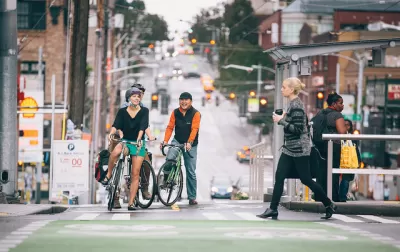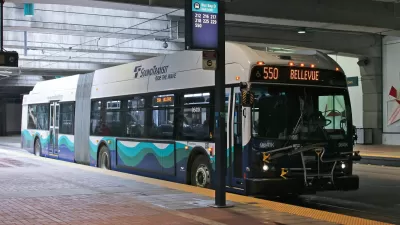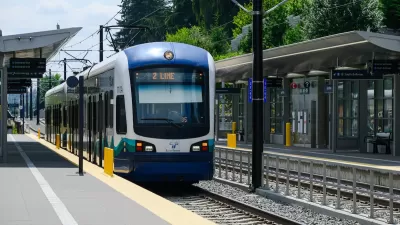The career of Emily Yasukochi, senior associate at Nelson\Nygaard, has offered an incredible variety of experience and institutions considering it's all been centered around transit and sustainable transportation.

Planetizen recently spoke with Emily Yasukochi about lessons and insights from a truly enviable career in public transit and mobility.
From working in transit service planning (the critical details of when, where, and how transit operates) to helping proliferate a new type of software designed specifically for transit planning purposes, the stops along the way in Yasukochi's career so far are unified by the common theme of matching the values of communities with transportation and mobility options.
Yasukochi's résumé is packed with exciting projects and positions, so there was plenty to discuss about the benefits of a career in planning, in transit planning more specifically, and how students might decide on the best path through the vast host of options planners will encounter over the course of a career.
The following interview was originally published in the 6th Edition of the Planetizen Graduate Urban Planning Programs on September 3, 2019.
Could you describe your current position: the kind of work you do and the goals for your organization?
In this position I do some project management and some technical planning work. I primarily focus on transit projects, and at Nelson\Nygaard we do all sorts of sustainable transportation planning—everything from transit to bike and pedestrian planning to parking management and transportation demand management (TDM).
My projects generally involve helping a public transit agency figure out the best way to allocate scarce resources. It usually involves looking at population and other demographic factors—car ownership, income, things like that—and understanding the values a community has around transportation and mobility. We help them create a vision for the future and implement changes to their existing transit network. A couple of my projects right now are focused on the future allocation of resources and building a decision-making framework for how to allocate those resources.

You’re based in Seattle, and that region and city have achieved some famous successes with implementing the kind of projects you’re describing. But it might be more difficult to achieve similar goals in other cities and parts of the county. What would you say to a young student who has very lofty ideals and ambitions for the future of transportation as a more sustainable proposition in this country?
There’s a lot of media attention around innovative new technologies, like with Elon Musk and whether autonomous vehicles are going to make transit irrelevant. But the bread and butter of transit planning is very much alive and well, and will continue to be into the future. All of these new technologies and new mobility options make transportation a really exciting field to work in, and a little scary.
There will always be a place for regular public transportation, and it’s very important. That’s the way communities will continue to take care of their needs and gain access to things like jobs and education that improve their quality of life. There are so many opportunities, and we need more smart people to come in and fight for options for regular people—not just wealthy people who have access to banks and smart phones.
You started out working for a transit agency and you’ve worked for other private companies advancing software or technological solutions to transportation challenges. How has each stop in your career built upon the next and evolved your thinking or professional practice?
Before planning school, I started out as a civil engineer and worked for a consulting firm for a couple of years doing highway design. That was when I realized, “oh my gosh, all of the decisions have already been made.” The way we built our transportation networks was forcing people into driving when they maybe didn’t want to or would like to have other options. I decided at that point that I wanted to be a planner, but needed to go to planning school to get the job that I wanted. I went to planning school, knowing I was going to do transportation because that’s where I started out. Transportation planning is at the nexus of civil engineering and environmental studies. I just didn’t know about it as an option as an undergrad.
In planning school, I did the transportation planning focus and we had a guest lecturer from one of the local transit agencies come in and talk about transit performance assessment and performance management. I was just in love. It was the perfect amount of nerdy, technical analysis while also working on something that’s super cool and can have a huge impact on people’s lives.
I went to work for an agency as a service planner. Service planning is looking at routes, schedules, and stops and figuring out how to optimize the system, given the existing resources. It’s a pretty technical task, and I just loved it. I had three years at that agency, and then I moved to a local agency in the same region and did more service planning work. That was great because I developed a really solid base in the technical aspects of doing service planning.
Then I had the opportunity to move back to the West Coast, where my husband and I are from, and went to work as a service planner for the large regional agency here in Seattle, Sound Transit. I did that for a couple of years, so I had six years of service planning under my belt and felt I was ready to move on to something different but stay in transit. That’s when I moved into the policy planner role. There I worked on developing programs and policies to help Sound Transit grow into a more mature transit agency. I was looking at things like pricing parking and partnerships with other mobility providers. A really solid understanding of transit operations has really helped throughout my career. Being able to understand a system and make recommendations—without that it would be much harder to do the work I do.
Continuing on from Sound Transit, at a conference I met a bunch of people from Remix, which is a transit planning software company. They were looking for people from the industry to come in and work with their customers to help their customers use the software in the day-to-day transit world. I really liked the company and thought it was really cool that there was a startup focusing on public transportation and demystifying the practice of transit planning. In a lot of smaller agencies, one person may have to wear many hats— one of which might be transit service planning and the other is operations manager. Remix was such a cool tool. I would have loved to have that tool when I was a transit planner.
I went to work for Remix at a point in my career when I wasn’t really sure where I wanted to develop my skills next, but I knew I wanted to continue growing. I knew nothing about the tech industry and nothing about startup life. I knew I’d be surrounded by a bunch of young, smart people. I spent a year at Remix and I learned so much. I feel like every step made me a more well-rounded planner. Everyone has a tendency to get pigeonholed once they start a job. I have tried to continue developing new skills. After a year at Remix, I realized I really missed doing actual planning work, so that’s why I moved on.
There was an opportunity here at Nelson\Nygaard, which I feel is one of the most respected transportation planning firms. Since I’ve been here, I started adding project management, which I’ve kind of been doing all along, but it’s really useful to learn from the consulting side. It’s really good to have worked for both the public agency side and the private sector side to see how they do business and understand how to work together. You’re always going to be working together, regardless of where you are.
What would you say to a young planner who’s faced with all of the intersections that you’ve encountered in your career and is trying to decide whether to develop project management skills, service management skills, or technological skills? How should someone find their way through the maze of all of these potential intersections in the field of planning?
One thing I’ve struggled with, and that I think I’m finally becoming okay with, is that my ambition does not need to match the ambition of my cohort. I have had to try to step back from thinking about my career in the context of what my peers are doing and just think about it in the context of what I truly want to be doing. Every day, I want to do something useful for the people I got into this work for—the people who have been denied opportunities by the way we’ve done things in the past. I will continue to do technical work, whereas some people who may have started at the same time as me who are currently managing a staff of 30, or have gotten higher than I have in terms of the org chart. I have had to be okay with that and know that I’ve been true to my values. When you come to those decision points, try not to think too much about what your peers are doing. You really should stay true to what your values are.
Do you have any final advice for students in planning right now beyond what you’ve already shared? Is there anything from your graduate school days that still informs your practice?
I learned most of my job skills on the job, at all of the jobs I had. My education provided a framework for thinking about problems and solutions. I am grateful to have an engineering degree because it drilled into me a super helpful way of thinking critically.
The planning way of thinking is the biggest thing that I got out of grad school. I definitely didn’t learn how to be a service planner in grad school, but I learned about the questions I should be asking and the things I should be thinking about as well as the various kinds of planning processes and ways to engage communities.
I really value having public and private sector experience, so don’t be afraid to move around. Looking at my resume as compared to someone in the tech world, it looks like I’m so dedicated because I stayed places for so long, but compared to more traditional people in the planning world, who might go somewhere and stay there for 15 years, it may seem like I’ve kind of jumped around. I value the diversity of experience that I have and think it’s made me a more well-rounded planner. If a potential future employer doesn’t value that, then I don’t want to work there.

Planetizen Federal Action Tracker
A weekly monitor of how Trump’s orders and actions are impacting planners and planning in America.

Maui's Vacation Rental Debate Turns Ugly
Verbal attacks, misinformation campaigns and fistfights plague a high-stakes debate to convert thousands of vacation rentals into long-term housing.

San Francisco Suspends Traffic Calming Amidst Record Deaths
Citing “a challenging fiscal landscape,” the city will cease the program on the heels of 42 traffic deaths, including 24 pedestrians.

Defunct Pittsburgh Power Plant to Become Residential Tower
A decommissioned steam heat plant will be redeveloped into almost 100 affordable housing units.

Trump Prompts Restructuring of Transportation Research Board in “Unprecedented Overreach”
The TRB has eliminated more than half of its committees including those focused on climate, equity, and cities.

Amtrak Rolls Out New Orleans to Alabama “Mardi Gras” Train
The new service will operate morning and evening departures between Mobile and New Orleans.
Urban Design for Planners 1: Software Tools
This six-course series explores essential urban design concepts using open source software and equips planners with the tools they need to participate fully in the urban design process.
Planning for Universal Design
Learn the tools for implementing Universal Design in planning regulations.
Heyer Gruel & Associates PA
JM Goldson LLC
Custer County Colorado
City of Camden Redevelopment Agency
City of Astoria
Transportation Research & Education Center (TREC) at Portland State University
Jefferson Parish Government
Camden Redevelopment Agency
City of Claremont





























